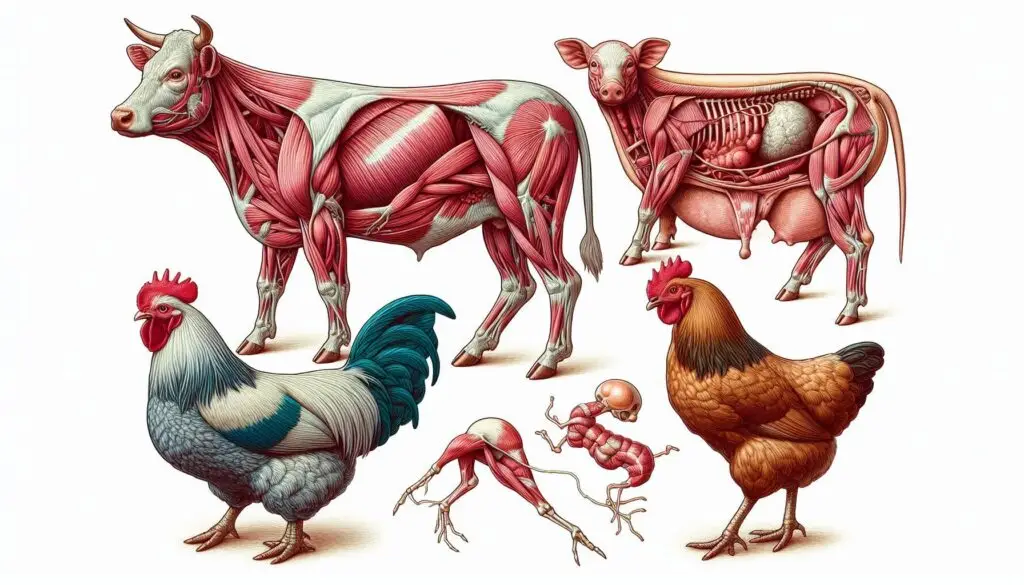Ears in Farm Animals

Introduction to Ears in Farm Animals
Ears play a crucial role in the lives of farm animals. They help these animals communicate, detect sounds, and regulate body temperature. Each species has unique ear structures adapted to its environment and lifestyle. In this article, we will explore the different types of ears found in common farm animals, their functions, and how to care for them.
Types of Ears in Common Farm Animals
Cattle Ears
Cows have large and broad ears that can rotate independently. This ability allows them to hear sounds from various directions. Their ears are not just for hearing; they also help regulate body temperature by dissipating heat. According to a study by the University of Florida, cattle can experience heat stress if their ears are not functioning properly.
Characteristics of Cattle Ears
- Size: Large and broad.
- Mobility: Can swivel independently.
- Function: Hearing and temperature regulation.
Pig Ears
Pigs exhibit a variety of ear shapes. Some breeds have large, floppy ears that can cover their eyes, while others have erect ears. Floppy ears may provide some protection from sun exposure but can also limit visibility. The National Pork Board provides resources on how ear shape can affect pig behavior and welfare.
Characteristics of Pig Ears
- Shape: Floppy or erect.
- Function: Hearing and social interaction.
Sheep and Goat Ears
Sheep typically have pointed ears that can swivel to locate sounds effectively. Goats may have both pointed and floppy ears depending on their breed. Their ear shape plays a significant role in their ability to hear predators. The American Sheep Industry Association emphasizes the importance of good hearing for sheep in avoiding threats.
Characteristics of Sheep and Goat Ears
- Shape: Pointed or floppy.
- Function: Hearing and predator detection.
Chicken Ears
Chickens have small ear openings located behind their eyes. These openings are covered by feathers, which protect them from dirt and debris. Despite their small size, chickens have excellent hearing capabilities. The Poultry Science Association highlights how sound perception affects chicken behavior.
Characteristics of Chicken Ears
- Size: Small with feather coverage.
- Function: Hearing environmental sounds.
Donkey Ears
Donkeys possess long and mobile ears that serve multiple purposes. They communicate with each other through ear movements and can detect sounds from great distances. The Donkey Sanctuary notes that donkeys rely heavily on their hearing for social interactions.
Characteristics of Donkey Ears
- Size: Long and mobile.
- Function: Communication and sound detection.
The Importance of Ear Care in Farm Animals
Proper ear care is essential for maintaining the health of farm animals. Regular cleaning and inspection can prevent infections caused by dirt, bacteria, or parasites. Neglecting ear health can lead to serious complications that affect an animal’s overall well-being.
Common Ear Problems in Farm Animals
- Ear Infections: These can occur due to moisture or dirt buildup.
- Ear Mites: Common in pigs and goats, these parasites can cause irritation.
- Fungal Infections: Often develop in warm, humid conditions.
How to Care for Animal Ears
Regular Inspection
Farmers should regularly check the ears of their animals for signs of infection or irritation. Look for redness, swelling, or discharge as indicators of potential problems.
Cleaning Routine
Use a soft cloth or cotton ball dampened with warm water to gently clean the outer part of the ear. Avoid inserting anything into the ear canal as this can cause injury.
Consult a Veterinarian
If you notice any unusual symptoms or persistent issues, consult a veterinarian immediately. Early intervention is crucial for effective treatment.
Earmarking Practices in Livestock Management
Earmarking is a traditional method used to identify livestock ownership and track important information such as age or breed. This practice involves making specific cuts or marks in an animal’s ear.
Types of Earmarks
- Notches: Small cuts made in specific patterns.
- Tags: Plastic or metal tags attached to the ear.
- Tattooing: Indelible ink used to mark identification numbers.
The American Veterinary Medical Association provides guidelines on best practices for earmarking livestock to ensure minimal stress during the process.
The Role of Ears in Animal Behavior
Ears significantly influence how farm animals interact with each other and their environment. For example:
- Communication: Animals use ear movements to signal emotions such as fear or aggression.
- Social Hierarchy: In herds, dominant animals may display more assertive ear positions.
Understanding these behaviors can help farmers manage their livestock more effectively.
Conclusion
Ears are vital organs for farm animals that contribute to their survival and well-being. Each species has developed unique adaptations that enhance their hearing capabilities while also serving other important functions like temperature regulation and communication. By understanding the characteristics of animal ears and implementing proper care practices, farmers can ensure healthier livestock and improve overall farm management.
For more information on animal welfare practices related to hearing and communication, you may refer to resources from organizations like World Animal Protection or Humane Society International.
More from Veterinary Anatomy:
Adrenal cortex






Responses